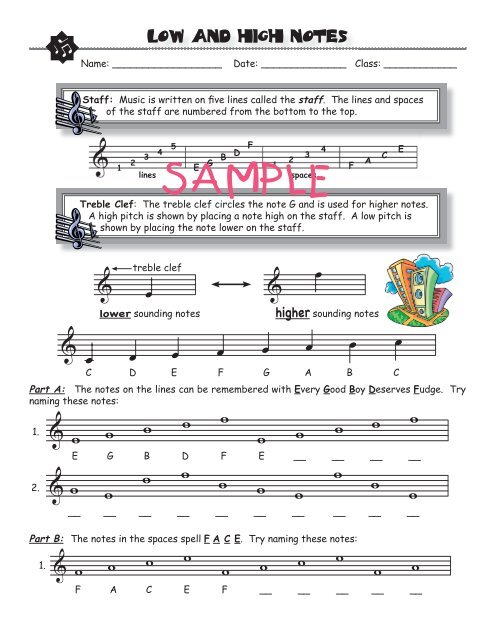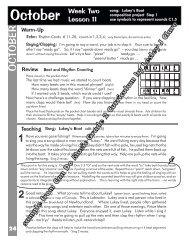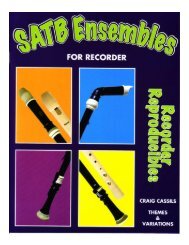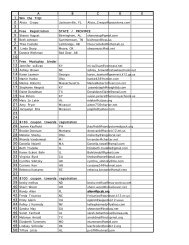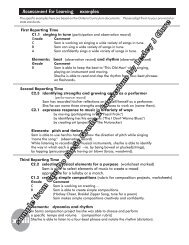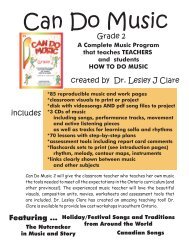Sample Pages Easy Music Theory.indd
Sample Pages Easy Music Theory.indd
Sample Pages Easy Music Theory.indd
Create successful ePaper yourself
Turn your PDF publications into a flip-book with our unique Google optimized e-Paper software.
1.<br />
q<br />
q<br />
qr<br />
Name: __________________ Date: ______________ Class: ____________<br />
1<br />
& œ<br />
5<br />
F<br />
4<br />
3<br />
D<br />
4<br />
B 3<br />
2 2<br />
SAMPLE<br />
E<br />
G 1<br />
lines spaces<br />
& w w w w w<br />
F<br />
A C E<br />
Part A: The notes on the lines can be remembered with Every Good Boy Deserves Fudge. Try<br />
naming these notes:<br />
2.<br />
1.<br />
& œ œ œ œ œ œ œ œ<br />
C D E F G A B C<br />
w w w w w<br />
E G B D F E __ __ __ __<br />
& w w<br />
w<br />
Part B: The notes in the spaces spell F A C E. Try naming these notes:<br />
& w w w w<br />
Low and High notes<br />
Staff: <strong>Music</strong> is written on fi ve lines called the staff. The lines and spaces<br />
of the staff are numbered from the bottom to the top.<br />
Treble Clef: The treble clef circles the note G and is used for higher notes.<br />
A high pitch is shown by placing a note high on the staff. A low pitch is<br />
shown by placing the note lower on the staff.<br />
treble clef<br />
w<br />
w w w<br />
__ __ __ __ __ __ __ __ __ __<br />
w w w w<br />
F A C E F __ __ __ __ __<br />
&<br />
lower sounding notes higher sounding notes<br />
œ<br />
w<br />
w<br />
w<br />
w<br />
w
q<br />
q<br />
qr<br />
Note Names in the Bass Clef<br />
Name: __________________ Date: ______________ Class: ____________<br />
SAMPLE<br />
G B D F A<br />
The bass clef notes on lines: The bass clef notes in spaces:<br />
Good Boys Deserve Fudge Always All Cows Eat Grass<br />
Part A: Name the bass clef notes found on lines.<br />
? œ<br />
œ œ<br />
œ œ œ<br />
Part B: Name the bass clef notes found in spaces.<br />
? œ<br />
Part C: Let‛s mix it up! Draw these notes on the staff that are found on lines and in spaces.<br />
?<br />
?<br />
Bass Clef: The bass clef is used for lower notes. The note F is found on<br />
the staff between the two dots.<br />
G B D F A A C E G<br />
___ ___ ___ ___ ___ ___ ___ ___ ___ ___<br />
œ œ<br />
œ œ<br />
œ<br />
œ<br />
œ<br />
œ<br />
œ œ<br />
___ ___ ___ ___ ___ ___ ___ ___ ___ ___<br />
A D F C E G B D<br />
G E C B A F D G<br />
œ<br />
œ<br />
œ
q<br />
q<br />
qr<br />
Treble and BAss Clef note Names<br />
Name: __________________ Date: ______________ Class: ____________<br />
Part A: Let‛s mix it up! Draw your clef. Name these notes found on lines and in spaces.<br />
1.<br />
2.<br />
3.<br />
Part B: Draw your clef. Write the following notes on the staff using whole notes.<br />
1.<br />
2.<br />
3.<br />
w<br />
w w<br />
A D E G C F A B<br />
C E B A G C B F<br />
E G C F D A C D<br />
Make a Hand Staff: Hold your hand in front of you with your fingers spread apart. Number<br />
your fingers 1-2-3-4-5 from the bottom to the top. That creates five lines, just as there are<br />
five lines on the staff. The spaces are found in between<br />
line 5<br />
your fingers. Spaces on the staff are also numbered<br />
from the bottom to the top.<br />
The first seven letters of the alphabet are used to<br />
name notes in order: A B C D E F G<br />
After G is named, the letters are used again beginning<br />
with A.<br />
w<br />
w<br />
w w<br />
__ __ __ __ __ __ __ __ __ __<br />
w<br />
w w w w w w<br />
w<br />
w SAMPLE<br />
w<br />
__ __ __ __ __ __ __ __ __ __<br />
w<br />
w<br />
w<br />
w<br />
w<br />
w<br />
w<br />
w<br />
w<br />
w<br />
w<br />
w w<br />
__ __ __ __ __ __ __ __ __ __<br />
line 1<br />
line 4<br />
line 3<br />
line 2
q<br />
q<br />
qr<br />
the grand staff<br />
Name: __________________ Date: ______________ Class: ____________<br />
Grand Staff: This example shows treble clef and bass clef notes. When two staves are joined<br />
it is called a grand staff.<br />
&<br />
?<br />
œ œ œ œ œ œ œ œ œ œ œ œ<br />
œ œ œ<br />
œ œ œ<br />
SAMPLE<br />
G A B C D E F G A B C D E F G<br />
Part A: Name the notes on the grand staff.<br />
& œ œ œ œ œ<br />
œ<br />
?<br />
œ œ œ œ œ œ<br />
Part C: Name the notes on the grand staff. The fi rst examples have been completed for you.<br />
&<br />
?<br />
œ œ œ œ œ<br />
œ œ œ<br />
∑<br />
œ<br />
œ<br />
œ œ<br />
œ œ œ œ œ<br />
∑<br />
œ œ œ œ œ œ<br />
œ œ œ œ œ<br />
œ<br />
œ<br />
œ œ œ<br />
œ œ<br />
Œ<br />
∑<br />
œ œ œ œ œ œ<br />
A B C D E F G A B C D E F G A<br />
œ œ œ<br />
__ E __ __ __ __ __ __ __ __ __ __ __ __ __ __ __ __ __<br />
Part B: Write the notes on the grand staff using whole notes.<br />
& w w<br />
?<br />
œ œ œ<br />
œ œ œ œ œ œ<br />
œ œ œ œ œ œ<br />
œ œ œ œ œ œ<br />
∑<br />
œ œ œ œ œ œ<br />
__ A __ B __ __ __ __ __ __ __ __ __ __ __ __ __ __ __ __ __ __ __ __ __ __ __ __ __ __ __<br />
œ œ œ<br />
œ œ œ<br />
__ D __ E __ __ __ __ __ __ __ __ __ __ __ __ __ __ __ __ __ __ __ __ __ __ __ __ __ __ __ __<br />
∑<br />
∑<br />
œ œ œ œ œ<br />
œ<br />
œ<br />
œ<br />
œ<br />
∑<br />
œ œ œ<br />
__ A __ __ __ __ __ __ __ __ __ __ __<br />
A D C E B F G A B F G A<br />
∑ ∑ w ∑<br />
G F D B F E D C
q<br />
q<br />
qr<br />
Dynamics<br />
Name: __________________ Date: ______________ Class: ____________<br />
Crescendo Gradually get louder.<br />
Decrescendo Gradually get softer. Italian words are used to<br />
describe<br />
SAMPLE<br />
different dynamics.<br />
These dynamics tell us to play the music loud. These dynamics tell us to play the music soft.<br />
Italian: Symbol: Play or Sing: Italian: Symbol: Play or Sing<br />
fortissimo ff very loud mezzo piano P medium soft<br />
forte f loud<br />
piano p soft<br />
mezzo forte F medium loud pianissimo very soft<br />
Write the name of the dynamics term in the blank.<br />
F f<br />
ff<br />
Dynamics: The dynamics in music refer to how loud or soft the music is.<br />
__________________<br />
___________________________<br />
__________________<br />
Fill in the blanks with the correct answer.<br />
p<br />
pp<br />
P<br />
pp<br />
__________________<br />
__________________________<br />
__________________<br />
1. Mezzo forte means ______________________________________.<br />
2. ______________________ means very loud.<br />
3. Dynamics tell us ___________________________________________________.<br />
4. Forte means _______________________.<br />
5. Write the abbreviation for: forte _____ fortissimo ____ mezzo forte ____<br />
6. Crescendo means ___________________________________. The symbol is _____<br />
7. Decrescendo means _________________________________. The symbol is _____<br />
8. ______________________ means very soft.<br />
9. Mezzo piano means __________________________.<br />
10. Write the abbreviation for: piano _____ pianissimo ____ mezzo piano ____<br />
11. List all the dynamics from loudest to softest: _____________________________<br />
_______________________________________________________________________<br />
_______________________________________________________________________
3<br />
4<br />
q<br />
q<br />
qr<br />
Note Value Practice<br />
Name: __________________ Date: ______________ Class: ____________<br />
q<br />
4 4 Q<br />
A quarter note receives one beat in time. A quarter rest receives one beat<br />
of silence.<br />
Draw a row of single eighth notes:<br />
? j<br />
œ SAMPLE<br />
Part A: Add a pair of eighth notes at the end of the measures and clap the rhythm patterns.<br />
? c œ œ œ œ ˙ œ œ œ œ œ œ<br />
Part B: Draw quarter notes , pairs of eighth notes and rests so there is one beat in<br />
each box.<br />
3<br />
4<br />
Two eighth notes can be joined with a beam and receive one beat in<br />
time.<br />
Draw pairs of eighth notes:<br />
? œ œ<br />
1 2 3<br />
1 2 3<br />
ee<br />
Write the rhythm pattern on the staff.<br />
? 4 3<br />
Write the rhythm pattern on the staff.<br />
? 4 3<br />
qr<br />
q qr Q<br />
4 4
q<br />
q<br />
qr<br />
Rhythm check-up - A<br />
Name: __________________ Date: ______________ Class: ____________<br />
These exampless are in time:<br />
w = 4 beats Q = rest 1 beat<br />
= 1 beat<br />
SAMPLE<br />
4<br />
Part A: Circle the measure that your teacher claps. These rhythms are in 4 time.<br />
A B C<br />
Example 1:<br />
Example 2:<br />
Example 3:<br />
Example 4:<br />
qr q qr q<br />
Part B: Your teacher is going to clap the following rhythms. Number the measures in the order<br />
that they were clapped. Listen carefully. All measures are in time.<br />
1.<br />
2.<br />
3.<br />
________ ________ ________<br />
________ ________ ________<br />
________ ________ ________<br />
Part C: Your teacher will clap one measure of music. Write the rhythm that your teacher claps.<br />
1.<br />
2.<br />
4<br />
4<br />
h<br />
q<br />
=<br />
2 beats<br />
4<br />
2 4<br />
qr = 1 beat<br />
q q qr q h h<br />
w qr qr q q qr q qr q<br />
h h w q q qr q<br />
q Q qr Q q q qr q qr Q q q<br />
q q qr q h<br />
q q<br />
qr qr<br />
q Q<br />
qr Q q Q<br />
h<br />
________<br />
qr qr<br />
________<br />
h<br />
________<br />
q q
q<br />
&<br />
?<br />
&<br />
?<br />
q<br />
qr<br />
Instrument Fingerings<br />
Name: __________________ Date: ______________ Class: ____________<br />
Part A: Write the notes of the Concert B scale in your clef. Draw the<br />
fi ngering for each note in the boxes above. Play the Concert B b scale on<br />
your instrument.<br />
SAMPLE<br />
____ ____ ____ ____<br />
____ ____ ____ ____<br />
____ ____ ____ ____<br />
____ ____ ____ ____<br />
b
q<br />
q<br />
qr<br />
Name: __________________ Date: ______________ Class: ____________<br />
Part A: Write the counts under the notes. This can help you to figure out how to play rhythms<br />
that are more difficult. Some of the measures have been completed for you. Clap the rhythms.<br />
1 2 3 4 1 2 3 4 1 2 3 4 1 2 3 4<br />
& c ˙ ˙<br />
& c ˙<br />
œ œ<br />
Counting Rhythms<br />
c<br />
*Hint: The means common time and is another way of writing time.<br />
w ˙ ˙ w<br />
SAMPLE<br />
1 2 3 4 1 2 3 4 1 2 3 4 1 2 3 4<br />
œ œ œ œ œ œ ˙ w<br />
In this example, there are two eighth notes on one beat. After you write in the counting, clap<br />
the rhythm or play on Concert B b .<br />
1 2 3 4 1 2 3 4 1 2 3 4<br />
c œ œ œ œ œ œ ˙ œ œ œ œ œ œ œ œ œ œ<br />
œ œ œ œ œ œ ˙ œ œ œ œ œ œ œ œ œ œ<br />
Part B: This section has tied notes. Write the counts under the notes.<br />
4 4
q<br />
q<br />
qr<br />
TEMPO AND DYNAMICs REVIEW<br />
Name: __________________ Date: ______________ Class: ____________<br />
A composer can indicate if they want the music to speed up or slow down. Accelerando means to<br />
gradually get faster (accel). Ritardando means to gradually get slower (rit).<br />
Part A: Write the letter of the definition that matches one of the tempo terms on the left.<br />
1. allegro ___<br />
2. vivace ___<br />
b. fast and lively<br />
SAMPLE<br />
3. accelerando (accel.) ___<br />
c. very quickly (as fast as you can go)<br />
4. prestissimo ___<br />
d. gradually get faster<br />
5. presto ___<br />
6. andante ___<br />
7. adagio ___<br />
8. ritardando (rit.) ___<br />
9. largo ___<br />
10. moderato ___<br />
Part B: Fill in the blanks with the correct answer.<br />
a. quickly<br />
e. quickly, lively and bright<br />
f. moderately, medium speed<br />
g. slow, at a walking pace<br />
h. very slow and broad<br />
i. slowly<br />
j. gradually get slower<br />
1. Accelerando (accel.) means to _____________________________________________.<br />
2. Ritardando (rit.) means to ____________________________________________.<br />
3. Fast and lively is called ____________________.<br />
4. Moderato is faster than ___________________ but slower than __________________.<br />
Part C: Write the letter of the definition that matches one of the dynamics terms on the left.<br />
1. piano ___<br />
2. fortissimo ___<br />
3. crescendo ___<br />
4. mezzo piano ___<br />
5. pianissimo ___<br />
6. forte ___<br />
7. decrescendo ___<br />
8. mezzo forte ___<br />
a. medium soft<br />
b. gradually get softer<br />
c. loud<br />
d. very loud<br />
e. soft<br />
f. medium loud<br />
g. very soft<br />
h. gradually get louder
q<br />
q<br />
qr<br />
Name: __________________ Date: ______________ Class: ____________<br />
& 4 3 œ œ œ œ<br />
Measures and Bar Lines<br />
1 2 3<br />
bar line<br />
& 4 3 œ œ œ œ<br />
measure measure<br />
measure measure<br />
SAMPLE<br />
3<br />
Œ<br />
4 Œ<br />
œ œ œ œ œ<br />
Time Signature: The time signature is a pair of numbers found after the treble or<br />
bass clef. The number on the top tells us how many beats are in œeach<br />
measure. The<br />
bottom number tells us what kind of note gets a single beat.<br />
Staff: <strong>Music</strong> is written on a fi ve line staff. The staff has fi ve lines and four spaces.<br />
Measures and Bar Lines: A bar line comes before an accented beat. A measure is the<br />
distance between bar lines. The double bar line tells you that it is the end of the piece.<br />
Part A: Answer the following questions:<br />
1. How many measures are in this example? ______<br />
2. What is a measure? ______________________________<br />
________________________________________________<br />
3. A bar line comes _______________ an accented beat.<br />
4. What is the space called that is found between bar lines?___________________<br />
5. Why is a double bar line used? ____________________________________________<br />
6. How many single bar lines do you count? ______<br />
bar line bar line<br />
1 2 3 1 2 3 1 2 3<br />
7. <strong>Music</strong> is written on fi ve lines (and four spaces) called the _____________.<br />
8. What is the time signature in the above example? _________<br />
Œ<br />
œ œ œ œ œ<br />
double bar line<br />
Clefs: Notes can be written in the treble clef<br />
l<br />
or bass clef , . This example is in the treble<br />
clef. The treble clef circles the note G and is used for higher notes. The bass clef circles the<br />
note F and is used for lower notes. What is your clef? ________________ Draw your clef<br />
across the blank staff.<br />
& l ,<br />
Œ<br />
œ
q<br />
q<br />
qr<br />
tongue slur slur<br />
Articulation<br />
Name: __________________ Date: ______________ Class: ____________<br />
Whisper this pattern: doo doo doo doo doo...doo... doo doo doo doo doo...<br />
When you say doo, your tongue lets the air out. This is called tonging. You should<br />
blow into your instrument the same way, connecting the notes.<br />
Part A: Draw your clef. Play this<br />
SAMPLE<br />
rhythm on your instrument, begin each note with “doo” or “too”.<br />
This is called tonguing the note.<br />
œ œ œ œ œ œ œ œ ˙ œ œ œ œ œ œ œ œ ˙<br />
doo doo doo-doo doo<br />
This example shows a slur. How do you play a slur on your instrument?<br />
When should you tongue a note?<br />
Tongue and Slur: Begin with “doo” and gently blow into your instrument on the following notes<br />
without tonguing. Notice how the first note is tongued and the notes after are slurred.<br />
Part B: For the slurs, tongue the first note and slur the following notes (play without tonguing).<br />
Make this musical selection unique. Draw your clef, choose your notes for the melody, practice<br />
and perform this mini-composition for the class.<br />
Part C: Draw your clef. Write To. under the note that should be tongued, and S under the notes<br />
that are slurred.<br />
To. ___ ___ S ___ S ___ ___ ___ ___ ___ ___ ___ ___ ___ ___ ___ ___ ___ ___ ___ ___ ___ ___ ___<br />
Staccato: A staccato means to play the note in a detached style. Play this example. Begin each<br />
note with “ta”.<br />
œ . œ . œ . œ . œ . œ . œ . œ . œ . œ . œ . œ . œ . œ . œ . œ . œ . œ . œ . œ . œ . œ .<br />
ta ta ta ta ta
c<br />
q<br />
q<br />
qr<br />
Conducting Patterns<br />
Name: __________________ Date: ______________ Class: ____________<br />
Common time is another way of writing time.<br />
& c<br />
The conducting pattern for is shown<br />
like this:<br />
3<br />
4<br />
3<br />
Create a rhythm pattern in 4 time. Practice conducting your pattern.<br />
& 4 3<br />
The conducting pattern for is shown<br />
like this:<br />
4<br />
2 4<br />
& 4 2<br />
The Conductor: The conductor interprets music and directs<br />
the musicians how to perform by different motions of his<br />
or her hands, or a baton. Conducting patterns are used for<br />
different time signatures.<br />
SAMPLE<br />
4<br />
The conducting pattern for is shown<br />
like this:<br />
4<br />
Create a rhythm pattern in 4 time. Practice conducting your pattern.<br />
2<br />
Create a rhythm pattern in 4 time. Practice conducting your pattern.
q<br />
q<br />
qr<br />
Whole and Half Steps<br />
Name: __________________ Date: ______________ Class: ____________<br />
The notes of the C scale are shown on the keyboard below. C to D is a whole step. You can tell<br />
it is a whole step because there is a black key between the white keys. E to F has no black keys<br />
in between, so E to F is a half step. Using the keyboard, write whether the following steps are<br />
whole or half steps.<br />
D<br />
whole step half step<br />
C to D is a whole step. D to E is a step. E to F is a half step.<br />
F to G is a step.<br />
I<br />
C to C is a half step. C to D is a whole step. A whole step has a note in between.<br />
C<br />
b<br />
I<br />
b b b b<br />
E<br />
G A B<br />
SAMPLE<br />
DI<br />
FI<br />
GI<br />
AI<br />
C D E F G A B C D<br />
G to A is a step.<br />
B to C is a step.<br />
A to B is a step.<br />
Part A: Draw your clef at the beginning of the staff. Write the notes on the staff using whole<br />
notes. Refer to the keyboard above and decide if the notes are a whole or half step apart. Circle<br />
whole or half.<br />
1.<br />
2.<br />
I<br />
A A B B C D E F<br />
whole / half whole / half whole / half whole / half<br />
I<br />
C C E E B C D E<br />
whole / half whole / half whole / half whole / half<br />
Part B: Answer the questions.<br />
b<br />
b<br />
1. How can you tell if the notes are a half step apart? _______________________________<br />
_______________________________________________________________________.<br />
2. A whole step means ______________________________________________________.<br />
Db<br />
C<br />
I
q<br />
q<br />
qr<br />
Key Signatures<br />
Name: __________________ Date: ______________ Class: ____________<br />
Part A: Write the pattern of whole and half steps in a major scale.<br />
___________, ___________, ___________, ___________, ___________, ___________, ___________<br />
Key Signature<br />
Sharps or fl ats at the beginning of the staff that tell us what key the music is in.<br />
SAMPLE<br />
This key signature has F I and C I.<br />
This is the key of D. F and C are sharp so that the pattern<br />
of whole and half steps is a major scale.<br />
D Major<br />
Scale<br />
Part B: Draw the pattern of whole and half steps for the D major scale above and the scales<br />
on the keyboards below. A whole step is written like this: A half step is written like this:<br />
C Major<br />
Scale<br />
A Major<br />
Scale<br />
G Major<br />
Scale<br />
B b Major<br />
Scale<br />
G A<br />
B<br />
b<br />
C D E F G A B C<br />
CI<br />
FI GI<br />
A B D E A<br />
Eb<br />
D F<br />
F<br />
B C D E G<br />
C<br />
D E<br />
FI<br />
CI<br />
I<br />
G A B<br />
Bb<br />
G A<br />
D<br />
I I<br />
Draw F and C in<br />
the key signature:<br />
*The C Major Scale has no<br />
sharps or fl ats so the key<br />
signature is left blank.<br />
Draw F I, C I and G I<br />
in the key signature:<br />
Draw F I in the key<br />
signature:<br />
Draw B b and E b in the<br />
key signature:


